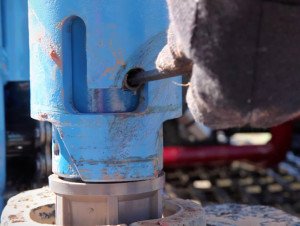Skipping over daily maintenance is like rushing to a jobsite without wearing steel-toed boots. Sure, you might get there in time to clock in, but there’s no guarantee how much longer you’ll be employed. However, routine maintenance ensures that any piece of equipment, such as a rotary drill, is ready-to-go and achieves its full service life.
A daily maintenance check doesn’t need to be lengthy or complicated. We’ll walk you through it.
Check grease levels first because that inspection guides you around the drill’s major components, including the drawworks, drive chain, mast and water swivel. Visit our blog to learn more about proper greasing — including the type to use, how much to use, and more.
While greasing the drawworks and mast, inspect the drive chain. Keep it tight and properly lubricated since the drawworks relies on it to raise and lower the drill pipe in the borehole, much like the drill line on a large drilling rig. Check the drive chain after about four hours of drilling and remove any slack, as necessary. A loose drive chain slaps against the drill’s mast while boring through overburden or rock formations.
Lone Star Drills designs rotary drills that make accessing the chain’s adjustment screw and locking nut as simple as possible: just remove a pin or loosen a bolt. This significantly minimizes downtime. To adjust the tension, open the rotary drive assembly and swing the drivehead to the side to access an adjustment screw and locking nut. Hold the adjustment screw and loosen the locking nut. Then, tighten the adjustment nut until nearly all the drive chain’s slack is removed. There should be a little slack because it prevents the chain from getting stuck at the top of the mast, but not so much that it slaps against the mast. After getting rid of the slack, tighten the locking nut and secure the drivehead into place.
 After inspecting and lubricating the main components, run through a daily checklist of bolts, plates and pipes. Ensure bolts are properly torqued according to the torque guide in the operators’ manual. Loose bolts can damage equipment or break off inside components, such as the J-latch. Keep slip plates clear of grease and soil to reduce the chance of rust.
After inspecting and lubricating the main components, run through a daily checklist of bolts, plates and pipes. Ensure bolts are properly torqued according to the torque guide in the operators’ manual. Loose bolts can damage equipment or break off inside components, such as the J-latch. Keep slip plates clear of grease and soil to reduce the chance of rust.
Properly cleaning and storing drill pipes allows the pipes to achieve a full service life. After drilling each hole, clean both the pin and box threads with a wire brush to remove any dirt or grease residue. After completing the job, clean any soil from the pipe and replace the thread protector caps before storing it in a trailer.
Be diligent about checking your rotary drill and completing daily maintenance to get the most out of your drill. And choose a reliable manufacturer to tackle any situations that fall outside of regular maintenance. For more information on drill maintenance, operation and selection as well as tips to maximize productivity, check our YouTube channel.